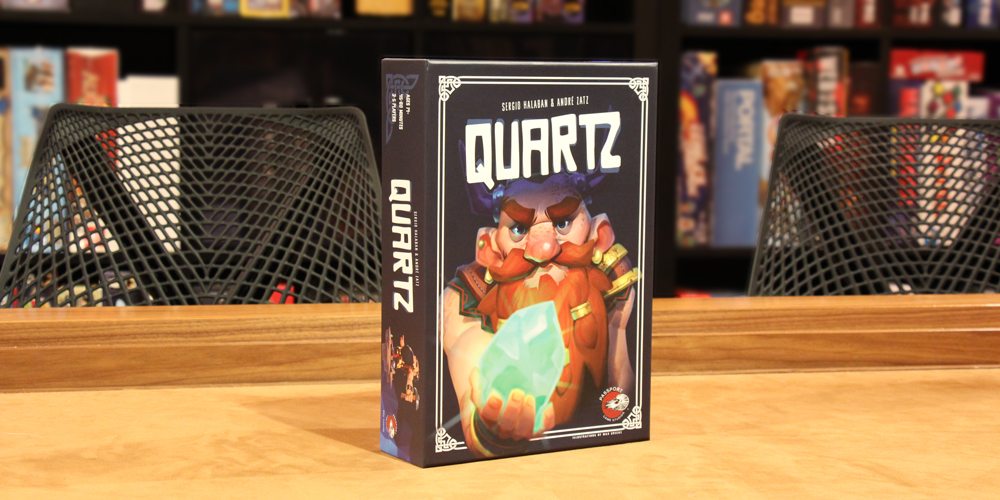
You and your fellow dwarves have discovered a new mine. Its depths hold untold riches–rare and valuable crystals, just waiting to be unearthed. Being dwarves, you form a wager: whoever uncovers the most profit after five days gets to keep the mine to himself. But be careful, your fellow dwarves aren’t as friendly as they seem!
At a Glance
Quartz, from Passport Game Studios, is a set collection/press your luck game for three to five players, aged 14 and up, that plays in 45-60 minutes. There are cards involved, which allow you to provide a healthy dose of “take that” to the other players. Quartz retails for $29.99 and is available, beginning today, from various online retailers and at your local game store.
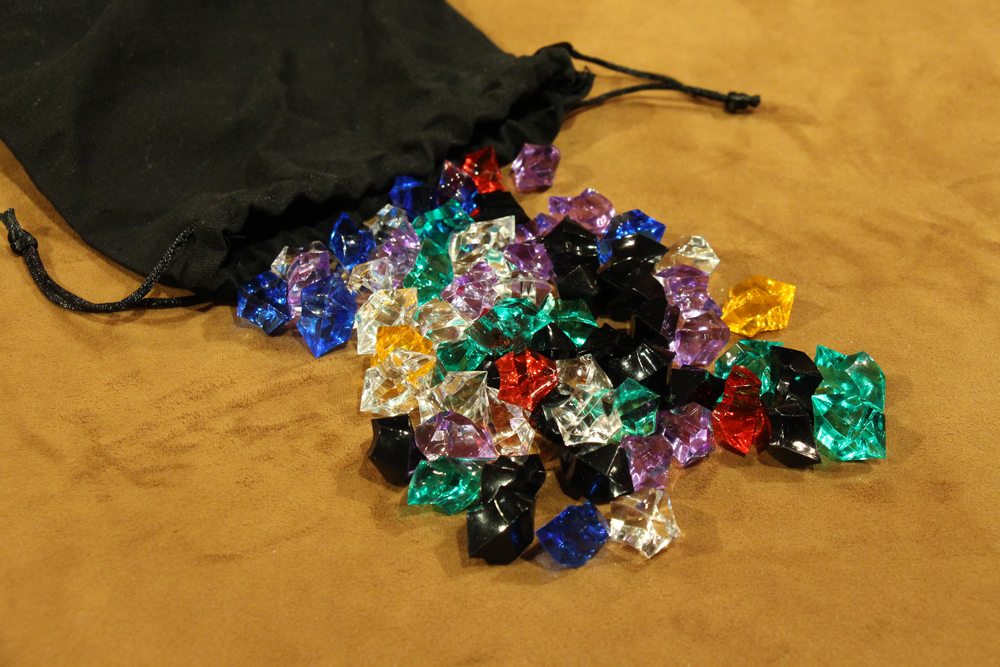
Components
First off, the components are really nice; for a $30 game, it has better components than some other games costing much more. Inside the box, you find a lot of cardboard: there are 84 coin tokens, which are earned by selling your crystals. There is a main board for tracking the days and forming the mining deck. The game comes five player boards (in the shape of mine carts). One side is used when you’re mining, the other when you leave the mine for the day. There are 55 mining cards which allow each dwarf to strike out against his compatriots or to protect himself. There are five more cards, chest cards, for protecting jewels from day to day. And there are experience tokens, more on those in a minute, that are represented by an image of a “Mining for Oafs” book–just a hint at the humor you’ll find in this game.
The core of the components, though, are the crystals. There are nearly 70 crystals in seven different colors. They are distributed by their values, more of the undesirable, few of the more cherished ones. All the crystals are shaped the same so you can’t discern which one you’re blindly picking from the cloth mine bag. All of it–the crystals, the cards, and cardboard is–of superb condition: thick cardboard, solid plastic crystals, and quality cards. The art is outstanding, there are great dwarf illustrations, really nice panoramas of the mine, and the box art is fantastic too.
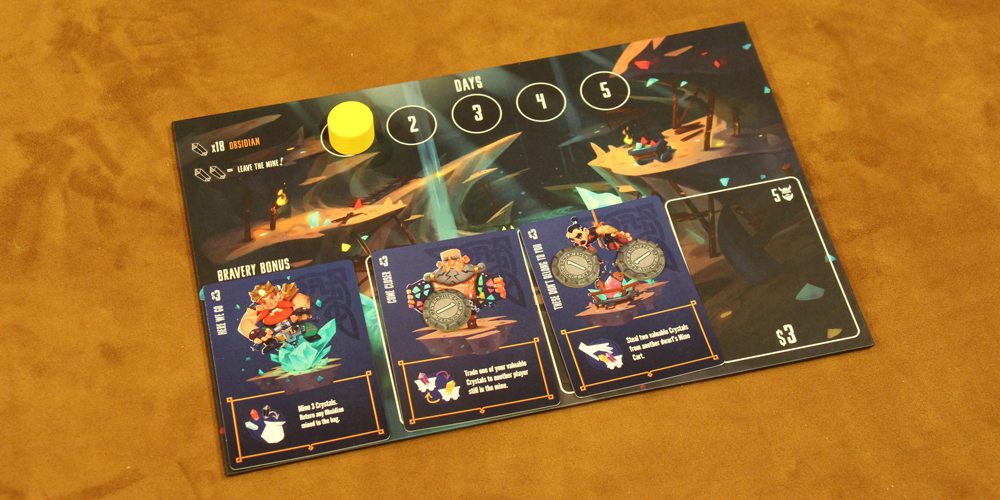
How to Play
For setup, give each player a mine cart, a chest card, and deal everyone five mining cards, face down. Put all the crystals in the mining bag, place the day marker on the first day on the main board and you’re ready to go.
Quartz consists of five rounds (days in the mine). To begin a day, players add mining cards to the main board. Cards are dealt out according to the formula, number of players, less one. (For four players, deal three cards.) For some of the spots, coins are added to the card. These cards and coins are bravery bonuses awarded to dwarves leaving the mine while there are at least two dwarves still mining.
The player with the longest beard (or the shortest player, absent facial hair) gets to go first. On a dwarf’s turn, he gets to choose from three actions. First, he may mine a crystal by blindly drawing from the mine bag. Second, he may play an action mining card, the cards with the blue background. Third, he may call it quits and leave the mine for the day by flipping his cart board.
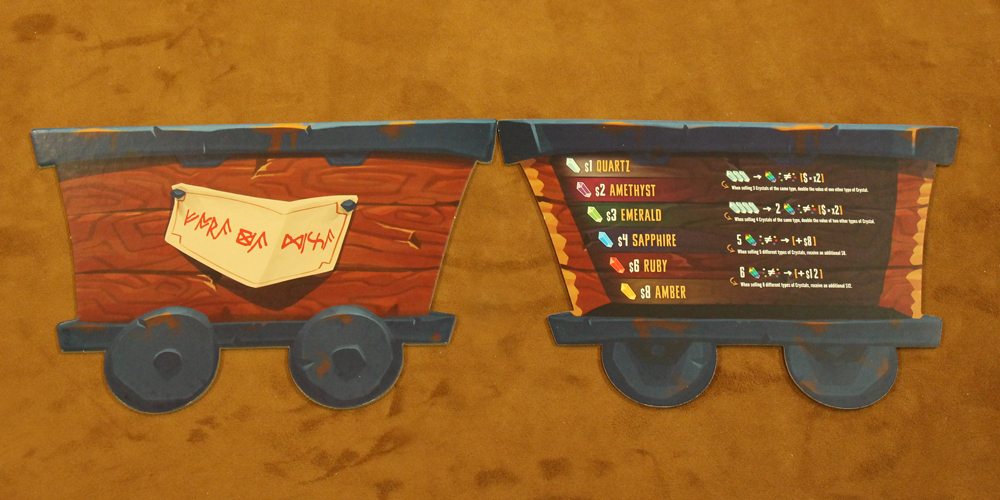
Summoning dwarven courage, the player reaches into the mine bag and pulls a crystal and places it on his mine cart. The crystals in the mine vary from the rare and valuable amber to rubies, sapphires, emeralds, amethyst, and more common, quartz. Unfortunately, in the mine there is an awful lot of obsidian, which the dwarves hate. It breaks too easily and is sharp and dangerous, so as part of the wager, any dwarf who mines two obsidian crystals has an accident, breaking his cart and forcing him to leave the mine for the day. All of his crystals are returned to the mine bag and he’s left to sulk outside the mine’s entrance. However, the dwarf also receives an Experience Token, with the “Mining for Oafs” book on it, which can be used to get rid of an obsidian at any time on future days. When this happens, players also remove the next bravery bonus.
If a dwarf decides he would rather play a blue-background action card, he may do that. The titles on these cards are pretty funny: “Out of My Waaaay” is illustrated with an alarmed dwarf and an out of control mine cart and forces other dwarves to discard a valuable crystal from their mine carts. “These Don’t Belong to You” allows the player to take two valuable crystals from another dwarf. There are also reaction cards, which a dwarf can play in defense to an action taken against him. If a dwarf were to play “This Isn’t Mine,” allowing him to give an obsidian to any other dwarf still in the mine (a great way to force someone already sitting on an obsidian out of the round), that dwarf could play the purple-background “Not Mine Either” and pass the obsidian along to someone else entirely. These are just a few of the cards.
When dwarves feel like they’ve pushed their luck far enough, they can leave the mine. When they decide to kick back for the rest of the day, they flip their mine cart board to show they are out and take the next bravery bonus card (and coin(s)).Once all dwarves have exited, they sell their crystals for the prices shown on the mine cart. Various combinations allow for bonuses and up to two crystals can be stored on a player’s chest card for a future day’s sale.
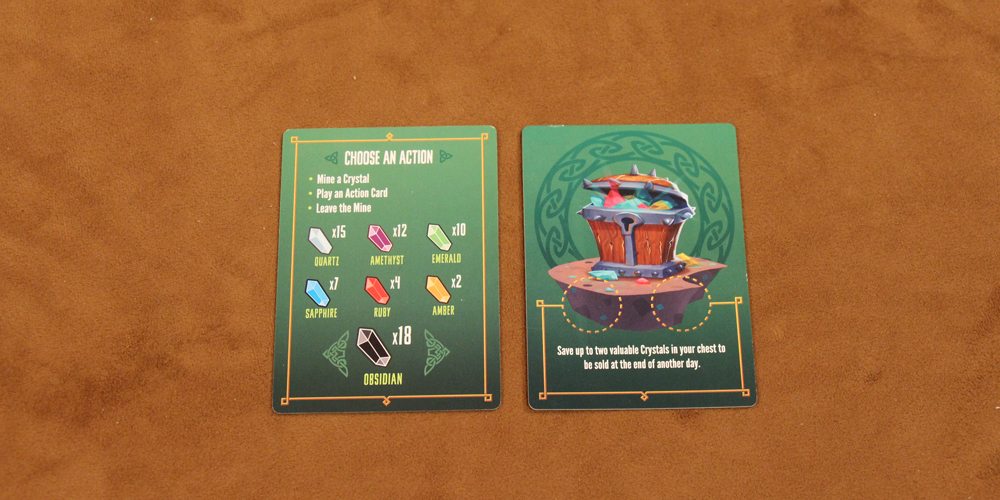
At the conclusion of sales, the day marker is advanced, players are dealt a single new mining card, and new bravery bonuses are revealed. Mine carts are all flipped and yesterday’s last dwarf out gets to go first. At the end of five days, money is added up. Unused mining cards and experience tokens are traded in for coinage and the dwarf with the most cash wins!
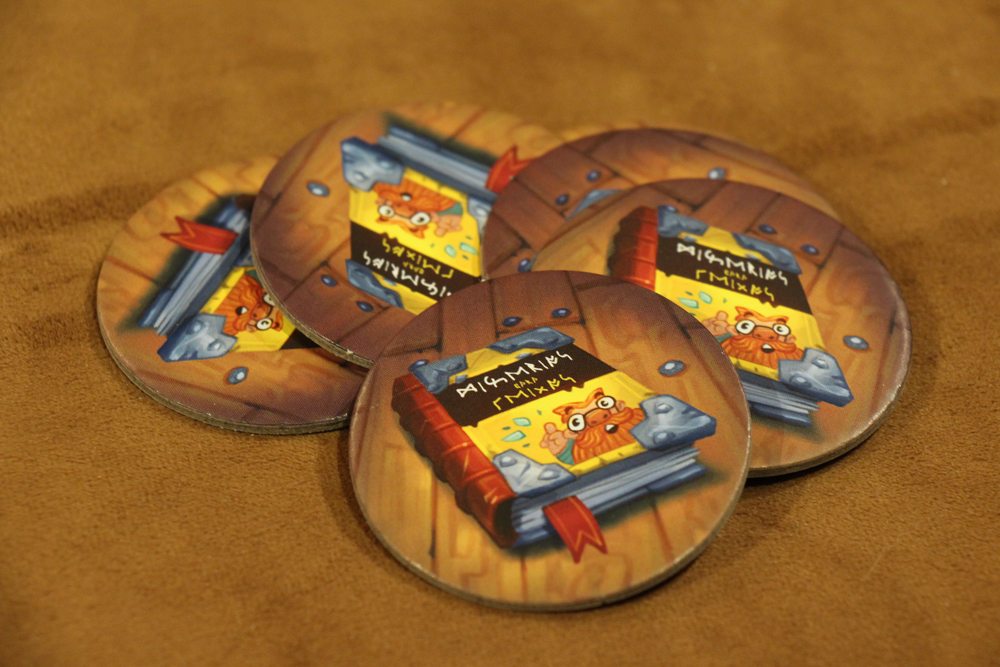
Verdict
We’ve really enjoyed Quartz every time we’ve played it. It plays a lot faster than its advertised 45-60 minutes. For us, it was closer to 30 every time. What’s more, it’s a game that can surely be played by those younger than 14, although some younger players may take offense at the take-that elements of the game.
With a high amount of luck, it’s a game that’s suited well for families; kids and adults stand equal chances of winning (or losing horribly). The Experience Tokens give eliminated players an advantage in future rounds that makes for a neat catch up mechanic.
The take-that aspect of the mining cards is fun, as long as players don’t gang up on one player. But that threat really acts as a counter, giving players reason to be judicious in their own attacks. It also results in pretty close games, since anyone who jumps out to a big lead is going to get stopped by other players trying to keep within striking distance.

Some people we played with felt some of the cards felt a bit overpowered. There’s one, “Eureka!,” that allows a dwarf to pull seven crystals from the mine bag and keep one. This is a great way to get a really valuable crystal. Other cards allow you to keep multiple crystals on a turn or trade crystals with another player. I thought some cards had greater powers than others, but I wouldn’t call them overpowered. The retaliation cards are a great option, but they only allow the player to respond to certain attacks. I’d love to have a retaliation card I could play against *any* attack.
Quartz is similar to another press your luck game, Incan Gold, but I prefer Quartz because it has more player interaction. It’s a reworking of a Brazilian game, Ouro de Tolo, but with some improvements including a better theme and a lot better art.
Quartz has made it to our table quite a few times. It’s simple to teach, fast to play, and pretty fun. We love the theme and with the mining cards and experience tokens, it’s a really great implementation of a press your luck game. Quartz is available for $29.99 today.

Disclosure: GeekDad was sent a sample of this game for review purposes.
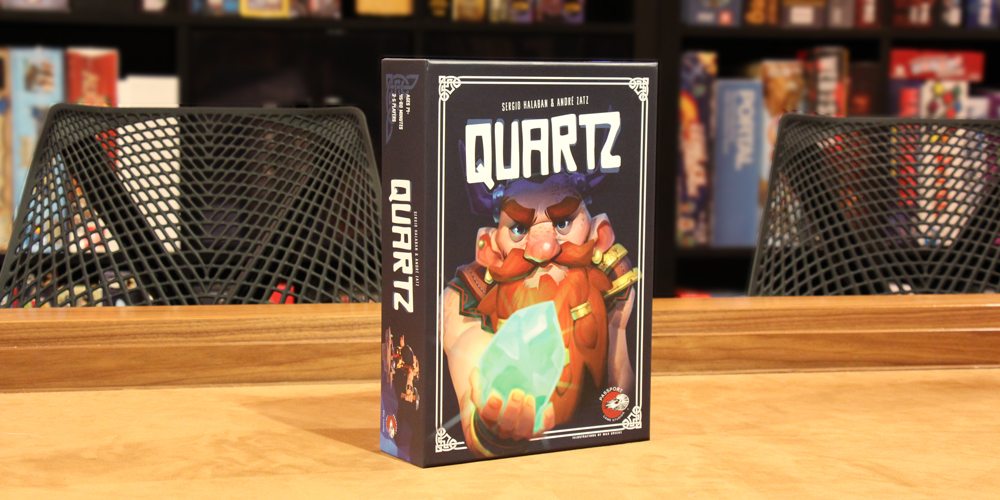




Could you review or comment on how you played the bravery bonus? I find that to be the hardest lrt for new players. To us, the rules shows that the first player gets a bravery bonus and the next player, and then the 2nd to last player. People we’ve played with have a hard time indesaynding why the bravery bonus goes to the first “chicken,” or person to go out.
They way I’ve tried to explain it to them is that the first “bravery card” is just a card with no extra money. And then the next player gets one card with a coin. And then (if in a 4 player game) the last two people “fight” over the last bravery bonus win two coins on it by that bonus going to the final player/miner- the person in the mine the longest.
This means the 2nd to last player out in this 4 player example would get no bravery bonus when they were arguably more bravery than the first two players out. I’m finding most people we play this against do not agree or like that.
You’re mostly right. There is always one less bravery bonus on round setup than the number of players.
The first out gets the card without coins on the left, second next card to the left with a single coin, and so on. In every round, it is only the last player out gets nothing (unless a reckless dwarf has had an accident).
If a dwarf has an accident in the mine, the next bravery bonus in line at that moment is discarded — reckless dwarves are never rewarded.
You’re right in the first out gets no money. Money never moves from card to card. The last two do “fight it out” in that the first out gets a bravery bonus. Last out gets nothing.
Hope that helps!
I have recently bought the game and found one mechanic that is not really clear. Maybe you could put some enlightenment on it?
Putting a gem saves that gem for the next day. At the start of the next day, should that gem be returned to the cart as a gem that can be lost again or will it be protected from any action or accident until you sell it and/or until the end of the last day?
Hi JP,
We were playing this game just this past weekend and ran into the same issue (again — wouldn’t it be nice if all rules were more clear?). Fortunately, the game’s designer, Sergio Halaban, has answered this question before: Your chest is your home. As long as they are there, they are safe and can stay there as long as you want, all the way to the end of the fifth day. However, crystals can only be moved into and out of the chest at the end of a given day.
I’m not a huge fan of this rule because it allows a player to capture both amber crystals and hang on to them and keep them out of play. I suppose that goes with the spirit of the game, but it would be nice if there was a card that disrupted this strategy.
Have fun playing!